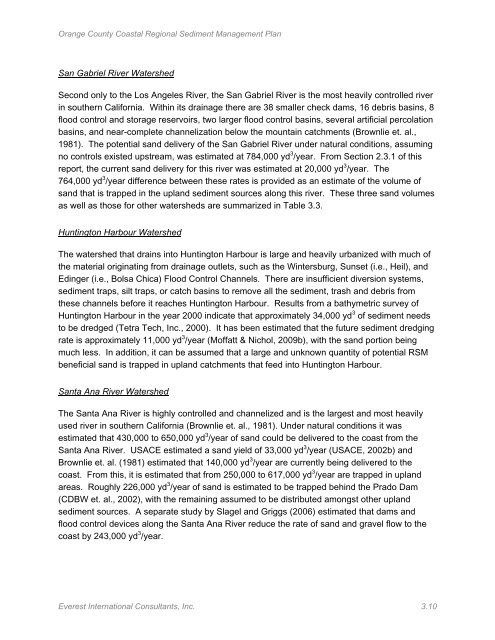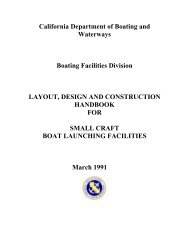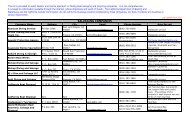EVEREST June, 2013 - California Department of Boating and ...
EVEREST June, 2013 - California Department of Boating and ...
EVEREST June, 2013 - California Department of Boating and ...
You also want an ePaper? Increase the reach of your titles
YUMPU automatically turns print PDFs into web optimized ePapers that Google loves.
Orange County Coastal Regional Sediment Management Plan<br />
San Gabriel River Watershed<br />
Second only to the Los Angeles River, the San Gabriel River is the most heavily controlled river<br />
in southern <strong>California</strong>. Within its drainage there are 38 smaller check dams, 16 debris basins, 8<br />
flood control <strong>and</strong> storage reservoirs, two larger flood control basins, several artificial percolation<br />
basins, <strong>and</strong> near-complete channelization below the mountain catchments (Brownlie et. al.,<br />
1981). The potential s<strong>and</strong> delivery <strong>of</strong> the San Gabriel River under natural conditions, assuming<br />
no controls existed upstream, was estimated at 784,000 yd 3 /year. From Section 2.3.1 <strong>of</strong> this<br />
report, the current s<strong>and</strong> delivery for this river was estimated at 20,000 yd 3 /year. The<br />
764,000 yd 3 /year difference between these rates is provided as an estimate <strong>of</strong> the volume <strong>of</strong><br />
s<strong>and</strong> that is trapped in the upl<strong>and</strong> sediment sources along this river. These three s<strong>and</strong> volumes<br />
as well as those for other watersheds are summarized in Table 3.3.<br />
Huntington Harbour Watershed<br />
The watershed that drains into Huntington Harbour is large <strong>and</strong> heavily urbanized with much <strong>of</strong><br />
the material originating from drainage outlets, such as the Wintersburg, Sunset (i.e., Heil), <strong>and</strong><br />
Edinger (i.e., Bolsa Chica) Flood Control Channels. There are insufficient diversion systems,<br />
sediment traps, silt traps, or catch basins to remove all the sediment, trash <strong>and</strong> debris from<br />
these channels before it reaches Huntington Harbour. Results from a bathymetric survey <strong>of</strong><br />
Huntington Harbour in the year 2000 indicate that approximately 34,000 yd 3 <strong>of</strong> sediment needs<br />
to be dredged (Tetra Tech, Inc., 2000). It has been estimated that the future sediment dredging<br />
rate is approximately 11,000 yd 3 /year (M<strong>of</strong>fatt & Nichol, 2009b), with the s<strong>and</strong> portion being<br />
much less. In addition, it can be assumed that a large <strong>and</strong> unknown quantity <strong>of</strong> potential RSM<br />
beneficial s<strong>and</strong> is trapped in upl<strong>and</strong> catchments that feed into Huntington Harbour.<br />
Santa Ana River Watershed<br />
The Santa Ana River is highly controlled <strong>and</strong> channelized <strong>and</strong> is the largest <strong>and</strong> most heavily<br />
used river in southern <strong>California</strong> (Brownlie et. al., 1981). Under natural conditions it was<br />
estimated that 430,000 to 650,000 yd 3 /year <strong>of</strong> s<strong>and</strong> could be delivered to the coast from the<br />
Santa Ana River. USACE estimated a s<strong>and</strong> yield <strong>of</strong> 33,000 yd 3 /year (USACE, 2002b) <strong>and</strong><br />
Brownlie et. al. (1981) estimated that 140,000 yd 3 /year are currently being delivered to the<br />
coast. From this, it is estimated that from 250,000 to 617,000 yd 3 /year are trapped in upl<strong>and</strong><br />
areas. Roughly 226,000 yd 3 /year <strong>of</strong> s<strong>and</strong> is estimated to be trapped behind the Prado Dam<br />
(CDBW et. al., 2002), with the remaining assumed to be distributed amongst other upl<strong>and</strong><br />
sediment sources. A separate study by Slagel <strong>and</strong> Griggs (2006) estimated that dams <strong>and</strong><br />
flood control devices along the Santa Ana River reduce the rate <strong>of</strong> s<strong>and</strong> <strong>and</strong> gravel flow to the<br />
coast by 243,000 yd 3 /year.<br />
Everest International Consultants, Inc. 3.10




